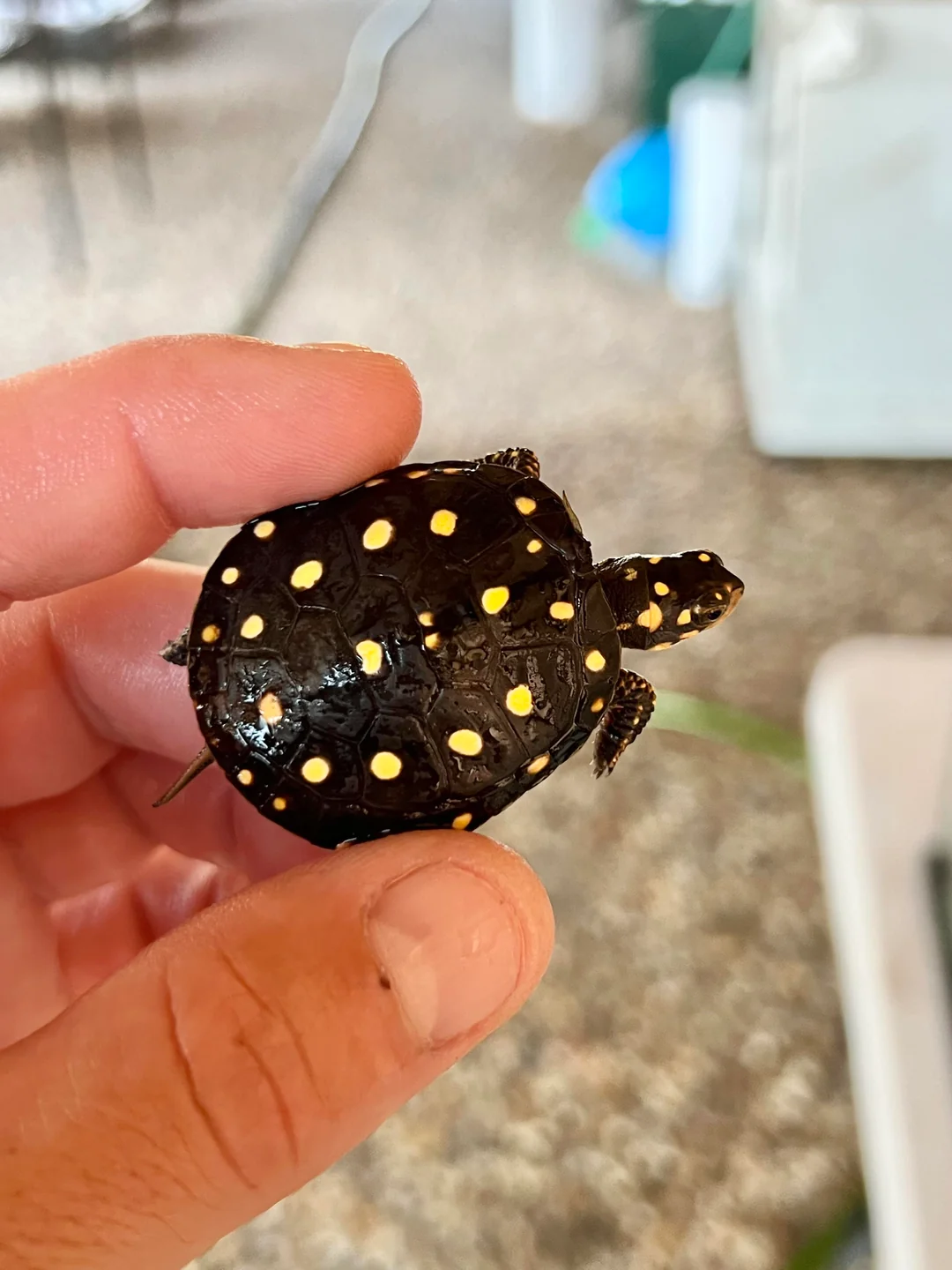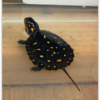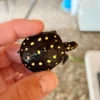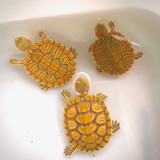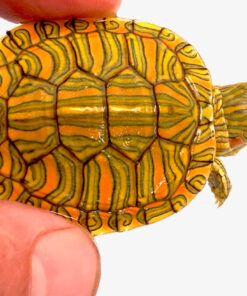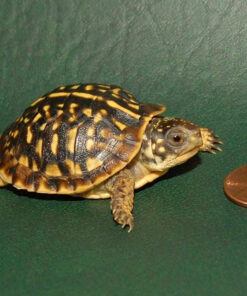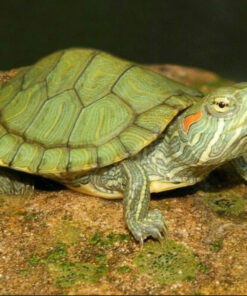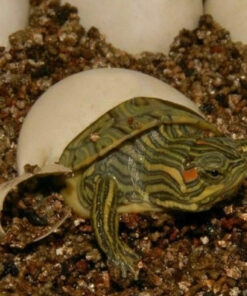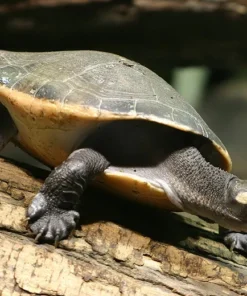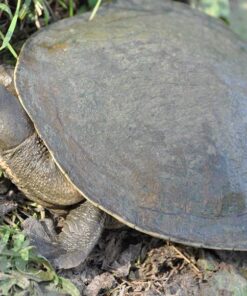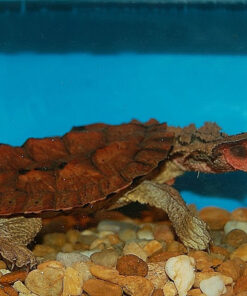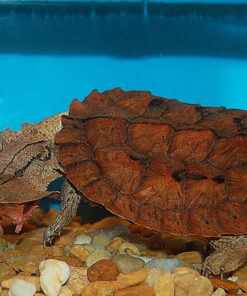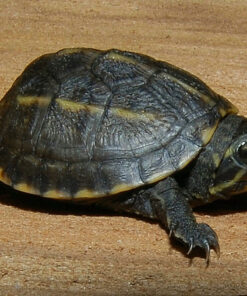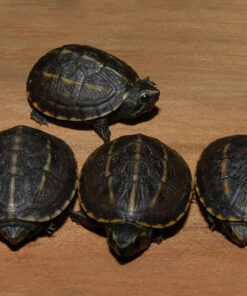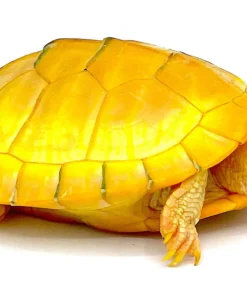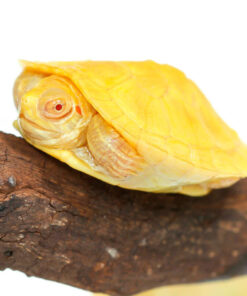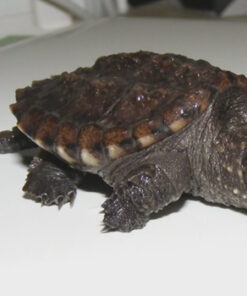$199.00 Original price was: $199.00.$149.00Current price is: $149.00.
Dive into the captivating beauty of our Baby Spotted Turtle collection. Visit our online store and bring home this charming turtle with its mesmerizing spotted pattern. Find your perfect companion and add a touch of wonder to your turtle collection!
SKU: N/A
Category: TURTLES FOR SALE
Baby Spotted Turtle for Sale : A Comprehensive Guide for Reptile Enthusiasts
The baby spotted turtle (Clemmys guttata) is a charming and popular species among reptile enthusiasts. Known for its distinctive yellow spots and manageable size, it has become a favorite for both beginner and experienced turtle keepers alike. Finding a spotted turtle for sale might be an exciting step towards owning one of these beautiful creatures, but it’s important to understand their needs, costs, and responsibilities before bringing one home.
In this comprehensive guide, we’ll cover everything you need to know about baby spotted turtles, from their care requirements to legal considerations and the typical spotted turtle price. Whether you’re interested in acquiring one or simply want to learn more about this fascinating species, this article will provide all the essential information.
What Makes Baby Spotted Turtles Special?
The spotted turtle is a small, semi-aquatic turtle that is native to the eastern United States and parts of Canada. Its distinctive yellow or orange spots against a dark shell make it visually unique among other turtle species. These turtles are relatively small, making them easier to care for in captivity than some larger species.
1. Appearance and Characteristics
At birth, baby spotted turtles have striking yellow spots on their blackish or dark brown shells. These spots become more prominent as the turtle grows, giving it a unique and attractive appearance. The number of spots varies between individuals, but they typically cover the carapace (upper shell), head, and limbs.
The plastron (the bottom part of the shell) is usually a mix of yellow and black, providing a beautiful contrast to the turtle’s dark upper shell. Baby spotted turtles are small, measuring around 1 inch in length when they hatch. As adults, they typically grow to a manageable size of 3.5 to 5 inches, making them one of the smaller turtle species commonly kept as pets.
2. Lifespan and Longevity
With proper care, a baby spotted turtle can live for several decades in captivity. Their lifespan can range from 25 to 50 years, making them a long-term commitment for pet owners. This longevity is one of the reasons why owning a spotted turtle requires thorough planning and dedication.
If you’re searching for a spotted turtle for sale, it’s important to consider the long-term care and attention these animals will need throughout their life. They are not short-term pets and should be viewed as lifelong companions.
Baby Spotted Turtle Care: Essential Information
Before purchasing a baby spotted turtle, it’s crucial to understand its specific care needs. These turtles have relatively simple but important habitat, dietary, and health requirements. Meeting these needs is essential for keeping your turtle healthy and happy.
1. Setting Up the Ideal Habitat
Since spotted turtles are semi-aquatic, they need both water and land areas in their enclosure. In the wild, these turtles inhabit wetlands, marshes, and ponds, so it’s important to replicate their natural environment as much as possible in captivity.
Tank Size: A single baby spotted turtle can initially live in a 20-gallon tank, but as they grow, a larger enclosure will be necessary. Adult spotted turtles will need at least a 40-gallon tank, or a similar-sized space in a pond setup, to provide enough room for swimming and basking.
Water Quality: Clean water is essential for your spotted turtle’s health. You’ll need a high-quality filtration system to keep the water clean and free of harmful bacteria. Regular water changes are also necessary to ensure good water quality.
Basking Area: Spotted turtles need a dry basking area where they can come out of the water and warm up under a heat lamp. The basking spot should reach a temperature of about 85-90°F, while the surrounding water should be kept at a more moderate temperature of 75-80°F.
Lighting: In addition to a heat lamp, UVB lighting is crucial for spotted turtles. UVB light helps them synthesize vitamin D3, which is necessary for proper calcium absorption and healthy shell development. Without UVB light, turtles can develop metabolic bone disease, which weakens their bones and shell.
Substrate: In the aquatic part of the enclosure, use smooth gravel or sand as the substrate. For the land area, you can use a mix of soil, moss, and rocks to create a natural environment for the turtle.
2. Diet and Nutrition
Baby spotted turtles are omnivores, meaning they eat both plant and animal matter. However, young turtles have higher protein requirements, so their diet should include more animal-based foods.
Protein: Offer your baby spotted turtle a variety of protein sources, such as small insects, worms, snails, and commercial turtle pellets. These foods will provide the necessary nutrients for growth and development.
Vegetables: As your turtle grows, you can start incorporating more vegetables into its diet. Leafy greens such as romaine lettuce, dandelion greens, and kale are excellent choices. Aquatic plants like duckweed and water lettuce can also be offered.
Calcium Supplementation: Turtles need plenty of calcium for healthy shell development. You can provide this by dusting their food with a calcium supplement or by placing a cuttlebone in their enclosure for them to nibble on.
Feed your baby spotted turtle once a day, and be sure to adjust the quantity of food as the turtle grows. Adult turtles can be fed every other day, but their diet should still consist of a balance of protein and vegetables.
3. Health Concerns and Common Issues
While spotted turtles are generally hardy, they can be susceptible to a few common health issues if not cared for properly.
Respiratory Infections: These can occur if the turtle is kept in water that’s too cold or if the air temperature drops too low. Symptoms include wheezing, lethargy, and a lack of appetite. If you notice any signs of respiratory infection, it’s important to consult a veterinarian who specializes in reptiles.
Shell Rot: Poor water quality or constant damp conditions can lead to shell rot, a bacterial infection that affects the turtle’s shell. To prevent shell rot, maintain a clean enclosure, provide a dry basking area, and monitor your turtle’s shell for any unusual soft spots or discoloration.
Vitamin Deficiencies: Without proper lighting or diet, turtles can suffer from vitamin deficiencies, particularly a lack of vitamin D3 and calcium. This can lead to metabolic bone disease, which weakens the bones and shell. Regular exposure to UVB light and a balanced diet will help prevent this.
Where to Find Baby Spotted Turtles for Sale
If you’re ready to bring a baby spotted turtle into your life, you’ll need to find a reputable seller. There are several options for purchasing spotted turtles, but not all sources are equal. Here’s what to look for when searching for a spotted turtle for sale.
1. Reputable Breeders
One of the best ways to ensure you’re getting a healthy, well-cared-for turtle is to buy from a reputable breeder. Breeders who specialize in spotted turtles will have a deep understanding of the species and will be able to provide you with information about the turtle’s health, lineage, and care requirements.
When buying from a breeder, make sure to ask questions about the turtle’s background and living conditions. Ethical breeders will be transparent about their breeding practices and will prioritize the health and well-being of their turtles.
2. Online Reptile Stores
Many online reptile stores offer spotted turtles for sale. These stores often provide a wide variety of turtles and reptiles, making them a convenient option for finding specific species like the baby spotted turtle. However, it’s important to do your research before purchasing from an online store.
Look for online stores with good reviews and a reputation for providing healthy animals. Make sure they offer live arrival guarantees and have a clear shipping policy to ensure your turtle arrives safely.
3. Pet Stores
While some pet stores carry baby spotted turtles, it’s important to exercise caution when purchasing from these locations. Not all pet stores provide the best care for reptiles, and turtles in these stores may be more prone to health issues.
If you decide to buy from a pet store, take the time to inspect the turtle’s living conditions and ask the staff about its care history. Avoid stores that keep turtles in overcrowded or unsanitary environments.
Spotted Turtle Price : What to Expect
The spotted turtle price can vary depending on factors like the turtle’s age, health, and where you purchase it. Baby spotted turtles tend to be less expensive than adults, but prices can still vary based on demand and availability.
Spotted Turtle Price Range: Generally, you can expect to pay between $150 and $500 for a baby spotted turtle. Prices may be higher if the turtle comes from a rare or particularly healthy bloodline.
Additional Costs: In addition to the initial purchase price, you’ll need to consider the ongoing costs of caring for your spotted turtle. This includes the cost of a suitable enclosure, heating and lighting equipment, water filtration systems, food, and veterinary care.
Legal Considerations for a Baby Spotted Turtle For Sale
Before purchasing a baby spotted turtle, it’s essential to check the legal regulations in your area. Spotted turtles are protected in some states and regions, and there may be restrictions on owning, buying, or selling them.
Make sure to research the laws in your state or country before purchasing a spotted turtle for sale. In some areas, you may need a special permit to own a spotted turtle, while in others, their sale may be restricted or prohibited.
| sex | Female, Male |
|---|
Related products
Sale!
TURTLES FOR SALE
TURTLES FOR SALE
$149.99
TURTLES FOR SALE
Red Ear Slider Turtle for sale | #1 Best Exotic Pets for Sale
$1,199.99
TURTLES FOR SALE
$274.99
TURTLES FOR SALE
$249.99
TURTLES FOR SALE
$149.99



